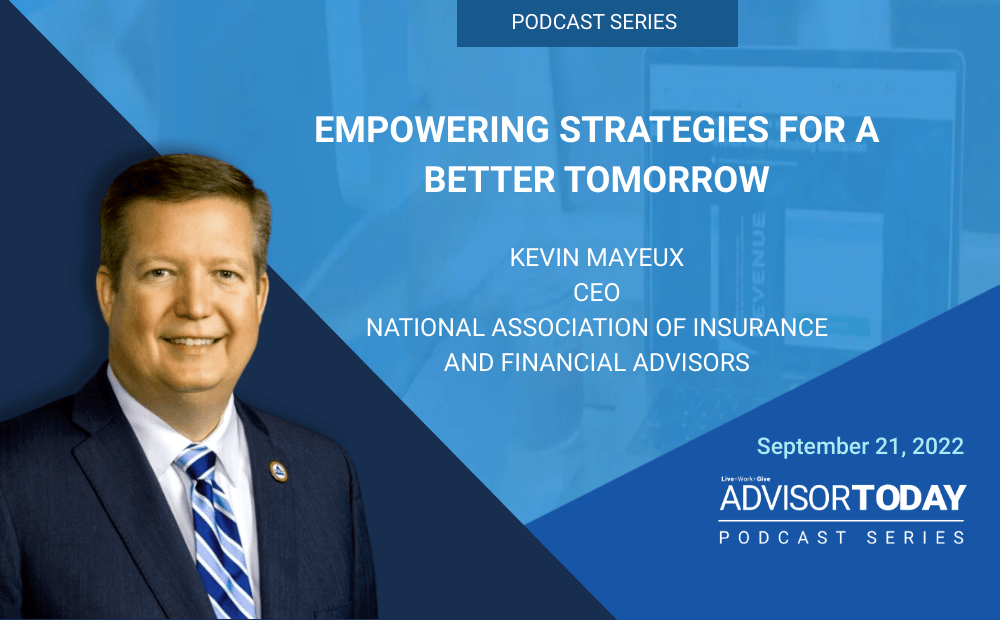Here are three ways people 62 and older (working in tandem with their advisors) can incorporate reverse mortgages into sound retirement plans to potentially improve retirement outcomes.
When it comes to making savings last over a lengthy retirement period, retirees have no shortage of obstacles to contend with: soaring inflation, longer life expectancy, volatile markets, exuberant long-term care costs — the list goes on and on.
Reverse mortgages can help solve many challenges in retirement. But too often the strategic use of home wealth, and consequently reverse mortgages, is something older-adult homeowners and their advisors fail to consider. Two big reasons why reverse mortgages are often omitted from the retirement-income planning conversation are outdated misconceptions and enduring perceptions about how reverse mortgages work and how they are best used. And that’s unfortunate because today’s reverse mortgages have some powerful features — along with recently enhanced consumer protections — that can make them a valuable and effective tool in retirement planning.
The most commonly utilized reverse mortgage in the nation is the Home Equity Conversion Mortgage (HECM), the only reverse mortgage insured by the Federal Housing Administration (FHA). While other investor-owned reverse mortgage loans are available, for simplicity, this article will focus solely on the HECM reverse mortgage.
What is a reverse mortgage?
A reverse mortgage is a home loan — exclusively for homeowners who are 62 or older — that allows the borrower(s) to convert a percentage of their home equity into cash, fixed monthly advances, or a line of credit. The borrower(s) can defer repayment of the loan balance so long as they reside in the home and pay the property charges, like taxes and insurance. The loan balance does not become due and payable until a maturity event occurs — typically the loan matures when all borrowers permanently move out of the home or the last surviving borrower passes away. Reverse mortgages are non-recourse loans, which means the reverse mortgage borrower(s), or their estate, will never owe more than the loan balance or the value of the property, whichever is less; and no assets other than the home has to be used to repay the debt.
How are reverse mortgages being used today?
There’s a longstanding belief that reverse mortgages are just a loan of last resort — an option to consider when all other options have been exhausted. While reverse mortgages can help homeowners to address an urgent need, like homeowners who can no longer afford their required monthly mortgage payment, this use case now represents a small (and diminishing) percentage of the overall reasons that borrowers take out a reverse mortgage. Now more than ever, consumers are working with advisors to use reverse mortgages in a financial planning sense — not only because it offers the borrower access to emergency funds, but also because of the long-term financial planning opportunities its growing line of credit presents. Many people are establishing the HECM line of credit as early as possible, prior to any urgent cash flow needs. There may be a future need or a strategy to maximize cash flow, reduce taxes, and minimize risk*.
Are disbursements from a reverse mortgage loan taxed as income?
No. Reverse mortgage loan proceeds are not taxable income. When your clients draw a portion of their cash flow needs tax-free, they may be able to keep their Adjusted Gross Income (AGI) low*.
Why is the HECM Line of Credit ideal for financial planning purposes?
It’s liquid home equity — the money can be borrowed, paid back, and borrowed again. The unused portion of the line of credit grows at the same compounding rate as the loan balance, meaning the borrower will have greater borrowing capacity in the future, if needed. The line of credit is also secure — it cannot be capped, frozen, or reduced because of market conditions.
Are disbursements from a reverse mortgage deductible?
It depends on what the loan proceeds are used for. While “home equity indebtedness” is no longer deductible (per the Tax Cuts and Job Act of 2017), “acquisition indebtedness” remains deductible. With a reverse mortgage, so long as the debt is incurred to acquire, build, or sustainably improve a primary residence, it counts as acquisition indebtedness. Use of reverse mortgage proceeds that may qualify for acquisition indebtedness include* refinancing a traditional mortgage, funding major home improvements, and buying a new home (primary residence).
Can a reverse mortgage be used to buy a new primary residence?
Yes. Historically, there have been two ways to purchase a new home: pay in cash or take out a mortgage with required monthly principal and interest mortgage payments. However, for homebuyers 62 and older, a reverse mortgage can be used in lieu of a traditional mortgage to finance part of the home’s purchase price. It’s called the Home Equity Conversion Mortgage for Purchase (H4P) loan, and is designed to help older adults to more affordably right-size into a new home that suits them better in retirement.
As with most traditional mortgage transactions, an H4P loan borrower must supply a down payment to supplement the H4P financing. The borrower can purchase a new home by putting about half the purchase price down from their own funds** (proceeds from sale of one’s current home can be used) — the remainder is funded by the H4P loan. The borrower is not required to make monthly principal and interest mortgage payments (must pay property charges, like taxes and insurance).
Here are some hypothetical scenarios of how a reverse mortgage can be used to enhance a sound financial plan.
NOTE: Stories are for illustration purposes only. The persons depicted herein are fictional and any resemblance to actual persons is a coincidence.
Scenario #1 — Paying for a Roth Conversion.
Let’s say John, a 65-year-old retiree, has $500,000 in a traditional pre-tax IRA and is looking to switch to after-tax Roth funds. John would have to pay $175,000 in income tax on the converted amount. John decides to use $175,000 from his HECM line of credit to pay the income tax on the converted amount. He doesn’t make any voluntary prepayments toward the reverse mortgage loan balance. At 5 percent interest annually, in 20 years, his loan balance climbs to $465,000. Now, what could John’s $175,000 be worth if not taxed in an investment that yields 7 percent return annually? $350,000 in 10 years? $700,000 in 20 years?
Using the reverse mortgage to pay for the Roth conversion, John, at age 85, would have a total investment (assuming 7 percent return annually) of $2 million, less the $465,000 to repay the reverse mortgage loan balance, or a net amount of $1.53 million.
If John didn’t go for a Roth Conversion, his total investment (assuming 7 percent return annually) at age 85 would be $2 million, less $800,000 (40 percent tax), or a net amount of $1.2 million.
If John did go for a Roth Conversion but used $175,000 from his investment funds to pay for the conversion (bringing investment at that time down to $325,000), his total investment (assuming 7 percent return annually) at age 85 would be a net amount of $1.25 million.
Bottom line is that John could end up with greater net wealth over time if he goes with a reverse mortgage to pay for the Roth conversion as opposed to not doing a Roth conversion or using investment funds to pay for the conversion.
Scenario #2 – Rightsizing to a new home.
Consider Sue, a retired widow homeowner, age 73, who wants to relocate and can net $300,000 on the sale of her existing paid-off home. She wants to right-size to a single-story home that’s closer to her family and the amenities she desires. She finds her ideal home, which is listed at $400,000.
Option 1: Pay all cash. Sue could use all of the proceeds from the sale of her current home ($300,000) and draw down on her retirement savings (use $100,000 out of her available $200,000 in retirement savings) to pay in all cash and own the home outright. While she wouldn’t be saddled with a monthly mortgage payment, she would have all of her previous home’s equity tied up in another very illiquid asset — her new home. Plus, she would have significantly depleted her retirement nest egg, reducing it from $200,000 to $100,000. Her cracked nest egg could hinder her retirement cash flow strategy going forward and increase the chances of her outliving her savings.
Option 2: Use a Traditional Mortgage. Sue could use about one-third of the proceeds from the sale of her current home to make a down payment on her new home using a traditional mortgage. This way, she can keep more of the proceeds from the sale of her current home to use as she wants (compared to all cash), and she wouldn’t have to dip into her retirement savings to complete the purchase. The downside of this approach is she will take on required monthly principal and interest mortgage payments during a phase of her life when her income is significantly less than it was through her prime working years. Assuming she’s financing $300,000 at a 5.5 percent interest rate on a conventional 30- year fixed rate mortgage, her monthly principal and interest mortgage payment would be $1,901. This repayment obligation, month after month, year after year, will result in a good chunk of her retirement cash flow being directed to and stored in her home — an asset that isn’t easily liquated. Her diminished cash flow in her golden years could make it more difficult for her to weather financial shocks, like a need to pay for her own in-home care.
Option 3: Use a Reverse Mortgage. Sue could use about three-fourths of the proceeds ($225,000) from the sale of her current home to apply toward the down payment of her new home using an H4P loan. This way, similar to the traditional mortgage approach, she can keep more of the proceeds from the sale of her current home to use as she wants (compared to all cash), and she wouldn’t have to dip into her productive retirement assets to complete the purchase. She can defer the repayment of the loan balance so long as she lives in the home and abides by the loan requirements. This repayment flexibility could help her to establish a more efficient retirement cash flow strategy. She also has increased buying power over the traditional mortgage or all-cash approaches. She could expand her new home search to include more pricey homes (ones that are double the value of her current home) — essentially, she can purchase a $600,000 home for about half the purchase price down, and still never have to make a monthly mortgage payment again. Of course, she must maintain the home and pay the property-related charges.
Scenario #3: Stacking deductions strategy.
Let’s continue working off of the previous scenario above, with the assumption that Sue went with the reverse mortgage (H4P) loan to fund part of the cost of her new home ($175,000 in acquisition indebtedness). And let’s throw in that Sue had established (at closing) a fully drawn HECM line of credit. For several years, Sue makes no voluntary prepayments toward the loan balance and interest and mortgage insurance premiums (MIPs) get tacked onto the balance, eventually bringing the balance to $235,000.
Step 1: Sue takes a voluntary distribution of $60,000 from her IRA, which triggers a 1099 as ordinary income.
Step 2: Sue makes a $60,000 voluntary interest payment to her HECM line of credit, reducing her balance owed to $175,000. That triggers a 1098 — as accrued interest (and maybe MIP depending on Congress each year) is potentially deductible in the year it is paid. That would be deductible under current tax rules as mortgage interest (or MIP) on Schedule A and it is well over the $25,100 standard deduction for a qualified widow 65 or older.
Step 3: Since a payment to the HECM line of credit dollar-for-dollar reduces the loan balance, Sue now has the amount she paid down as new borrowing capacity in the line — no liquidity is lost. She can either withdraw $60,000 from the line of credit tax-free*, or she can keep the $60,000 in the line of credit so it can grow (giving her greater borrowing capacity over time). It would be possible for Sue to use this strategy several times over a lengthy retirement period.
Learn more.
There are many circumstances that reverse mortgages can help you to help your clients fill in the gaps of a retirement plan. Let’s have a discovery conversation around how reverse mortgages can fit into your practice. Contact a local Fairway Independent Mortgage Corporation retirement mortgage specialist today.
*This advertisement does not constitute tax and/or financial advice from Fairway.
**The required down payment on your new home is determined on a number of factors, including your age (or eligible non-borrowing spouse’s age, if applicable); current interest rates; and the lesser of the home’s appraised value or purchase price.
Copyright©2022 Fairway Independent Mortgage Corporation. NMLS#2289. 4750 S. Biltmore Lane, Madison, WI 53718, 1-866-912-4800. Distribution to general public is prohibited. All rights reserved. Equal Housing Opportunity.
.png?width=728&height=89&name=2024%20Congressional%20Conference%20(728%20x%2089%20px).png)












.png?width=300&name=NAIFA-FSP-LH%20with%20tagline%20-%20AT%20blog%20email%20ad%20(300%20x%20250%20px).png)
